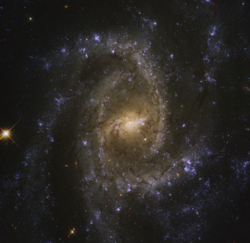Astronomy:NGC 2835
| NGC 2835 | |
|---|---|
 NGC 2835 by Hubble Space Telescope | |
| Observation data (J2000 epoch) | |
| Constellation | Hydra |
| Right ascension | 09h 17m 52.9s[1] |
| Declination | −22° 21′ 17″[1] |
| Redshift | 0.002955 ± 0.000007 [1] |
| Helio radial velocity | 886 ± 2 km/s[1] |
| Distance | 33.8 ± 8.5 Mly (10.4 ± 2.6 Mpc)[1] |
| Apparent magnitude (V) | 10.3[2] |
| Characteristics | |
| Type | SAB(rs)c [1] |
| Apparent size (V) | 6.6′ × 4.4′[1] |
| Notable features | Extended HIPASS source[1] |
| Other designations | |
| UGCA 157, ESO 564-G035, AM 0915-220, MCG -04-22-008, PGC 26259[1] | |
NGC 2835 is an intermediate spiral galaxy located in the constellation Hydra. It is located at a distance of circa 35 million light years from Earth, which, given its apparent dimensions, means that NGC 2835 is about 65,000 light years across. It was discovered by Wilhelm Tempel on April 13, 1884.[3] NGC 2835 is located only 18.5 degrees from the galactic plane.[4]
NGC 2835 is seen nearly face-on. The galaxy features four or five spiral arms, visible in near infrared due to their population II stars.[5] The spiral arms have also numerous HII regions and stellar associations, the larger of which are 5 arcseconds across.[4] Although the galaxy is quite symmetric, the northern arms have HII regions that appear brighter than the southern ones. Also the southern arms appear less developed in their outer parts than the north ones.[6] The star formation rate in NGC 2835 is 1.3 M☉ per year and the total stellar mass of the galaxy is 1010 M☉.[7] In the centre of NGC 2835 lies a supermassive black hole whose mass is estimated to be 3-10 million (106.72±0.3) M☉, based on the spiral arm pitch angle.[8]
NGC 2835 is the foremost galaxy in a small group of galaxies, the NGC 2835 group. Other galaxies identified as members of the cluster are ESO 497-035, and ESO 565-001.[9] A bit farther away, at projected separation of 2.2 degrees, lies NGC 2784 and its small galaxy group.[4][9]
See also
- NGC 5068 - another low mass spiral galaxy
References
- ↑ 1.0 1.1 1.2 1.3 1.4 1.5 1.6 1.7 1.8 "NASA/IPAC Extragalactic Database". Results for NGC 2835. http://ned.ipac.caltech.edu/cgi-bin/nph-objsearch?objname=NGC+2835.
- ↑ "Revised NGC Data for NGC 2835". http://spider.seds.org/ngc/revngcic.cgi?NGC2835.
- ↑ Seligman, Courtney. "NGC 2835 (= PGC 26259)". http://cseligman.com/text/atlas/ngc28.htm#2835.
- ↑ 4.0 4.1 4.2 Sandage, A., Bedke, J. (1994), The Carnegie Atlas of Galaxies. Volume I, Carnegie Institution of Washington
- ↑ Kirby, Emma M.; Jerjen, Helmut; Ryder, Stuart D.; Driver, Simon P. (1 November 2008). "Deep Near-Infrared Surface Photometry of 57 Galaxies in the Local Sphere of Influence". The Astronomical Journal 136 (5): 1866–1888. doi:10.1088/0004-6256/136/5/1866. Bibcode: 2008AJ....136.1866K.
- ↑ Ryder, Stuart D.; Dopita, Michael A. (October 1993). "An H-alpha atlas of nearby southern spiral galaxies". The Astrophysical Journal Supplement Series 88: 415. doi:10.1086/191827. Bibcode: 1993ApJS...88..415R.
- ↑ Leroy, Adam K.; Schinnerer, Eva; Hughes, Annie; Rosolowsky, Erik; Pety, Jérôme; Schruba, Andreas; Usero, Antonio; Blanc, Guillermo A. et al. (2021-12-01). "PHANGS–ALMA: Arcsecond CO(2–1) Imaging of Nearby Star-forming Galaxies". The Astrophysical Journal Supplement Series 257 (2): 43. doi:10.3847/1538-4365/ac17f3. ISSN 0067-0049. https://iopscience.iop.org/article/10.3847/1538-4365/ac17f3.
- ↑ Davis, Benjamin L.; Berrier, Joel C.; Johns, Lucas; Shields, Douglas W.; Hartley, Matthew T.; Kennefick, Daniel; Kennefick, Julia; Seigar, Marc S. et al. (20 June 2014). "The Black Hole Mass Function Derived from Local Spiral Galaxies". The Astrophysical Journal 789 (2): 124. doi:10.1088/0004-637X/789/2/124. Bibcode: 2014ApJ...789..124D.
- ↑ 9.0 9.1 Makarov, Dmitry; Karachentsev, Igor (21 April 2011). "Galaxy groups and clouds in the local (z~ 0.01) Universe". Monthly Notices of the Royal Astronomical Society 412 (4): 2498–2520. doi:10.1111/j.1365-2966.2010.18071.x. Bibcode: 2011MNRAS.412.2498M. http://www.sao.ru/hq/dim/groups/galaxies.dat. Retrieved 30 November 2018.
External links
- NGC 2835 on WikiSky: DSS2, SDSS, GALEX, IRAS, Hydrogen α, X-Ray, Astrophoto, Sky Map, Articles and images
 |

